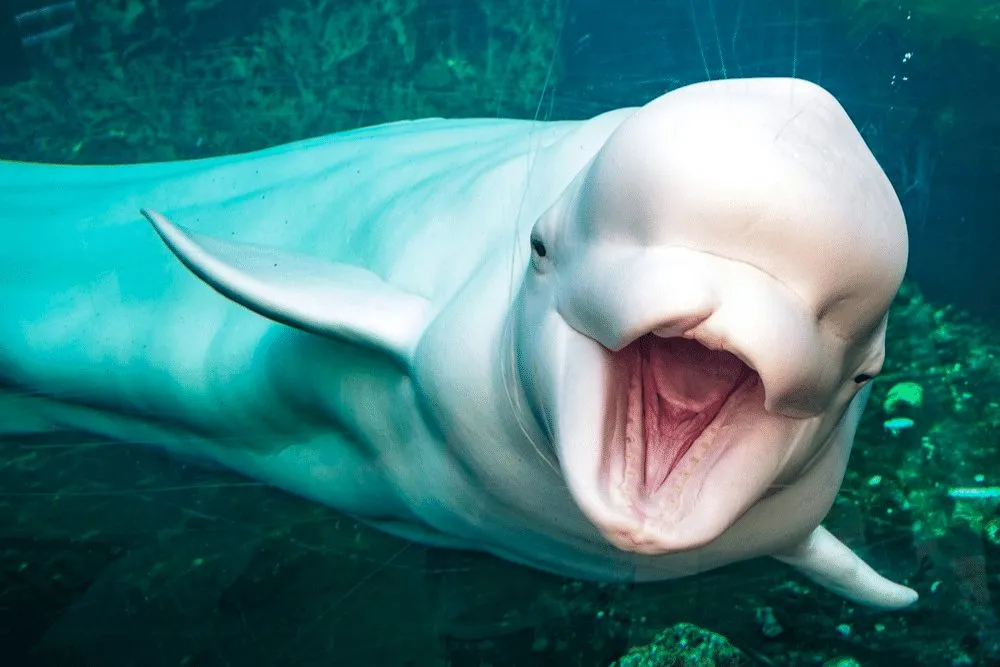ranchosantafenow.net – Beluga whales, also known as Delphinapterus leucas, are fascinating marine mammals recognized for their distinctive white color and playful nature. Native to the Arctic and sub-Arctic regions, these charismatic creatures have captured the interest of scientists, conservationists, and marine enthusiasts alike. Here’s an in-depth look at the beluga whale and what makes it so unique.
Physical Characteristics
One of the most distinguishing features of the beluga whale is its white or pale gray skin, which helps it blend in with its icy surroundings. Unlike most whales, belugas lack a dorsal fin, an adaptation that allows them to move easily under ice sheets. They are relatively small compared to other whales, with adults measuring between 13 to 20 feet long and weighing around 2,000 to 3,000 pounds. Another unique feature is their bulbous forehead, known as a “melon,” which is flexible and aids in echolocation, allowing the whale to navigate and hunt in the dark waters.
Social Behavior and Communication
Beluga whales are highly social animals and are often seen in pods of up to 10 individuals, though during certain times, larger groups of several hundred may form. They are extremely vocal and have earned the nickname “sea canaries” because of their wide range of sounds, including whistles, clicks, and chirps. These vocalizations, along with body language, are essential for communication within the pod.
Habitat and Range
Belugas inhabit the cold waters of the Arctic Ocean and its surrounding seas. They are found in regions such as the Bering Sea, the Beaufort Sea, the Sea of Okhotsk, and parts of the Canadian Arctic Archipelago. During the summer, some beluga populations migrate to estuaries and river mouths, seeking warmer waters and abundant food. In winter, they return to the open ocean, often swimming beneath ice-covered waters.
Diet and Feeding Habits
Beluga whales have a diverse diet, primarily feeding on fish, crustaceans, and marine invertebrates. They are opportunistic feeders and use echolocation to locate prey in murky waters or under the ice. Unlike many whale species, belugas are capable of swimming backward, which is a useful trait when maneuvering in tight spaces or hunting in complex underwater environments.
Conservation Status
Beluga whales face several threats, including habitat loss due to climate change, pollution, and human activities such as shipping and oil exploration. In some regions, they are also hunted by indigenous communities for their meat and blubber, a practice that is regulated to ensure sustainability. The International Union for Conservation of Nature (IUCN) lists belugas as “Near Threatened,” with some populations in greater danger than others, particularly those in the St. Lawrence River and Cook Inlet, Alaska.
Cultural Significance
Beluga whales hold significant cultural importance for many Arctic indigenous communities. For centuries, these communities have relied on belugas for food, clothing, and tools. The whale’s adaptability and survival in harsh environments are qualities admired by these cultures, and beluga hunting is often steeped in tradition.
Conclusion
The beluga whale is a remarkable species, admired for its adaptability, intelligence, and social nature. However, the changing environment and human activities present growing challenges for their survival. Conservation efforts are crucial to ensuring that future generations can continue to witness the beauty and wonder of these “canaries of the sea.” By protecting their habitats and mitigating the impact of climate change, we can help secure a future for the beluga whale.
